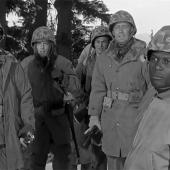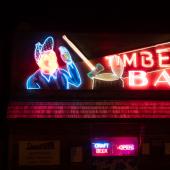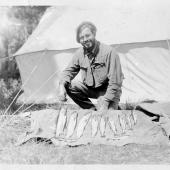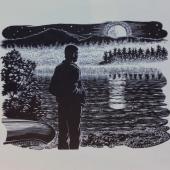Montana Artist Diana Tremaine

Fine art painter Diana Tremaine grew up influenced by her aunt and uncle’s well-known contemporary art collection. But it wasn’t the paintings per se that instilled a love of beauty in her. It was listening to her aunt talk about the work.
“They had some major paintings, a whole room devoted to Andy Warhol, an unfinished Piet Mondrian, a beautiful Miro – a line drawing of a cat – but what I remember most was having my aunt explain it all to me,” Diana says. “My aunt was the heart, guiding the collection on what she felt was moving.”
Eight years old, looking at the color-field work of a Mondrian, she turned to her aunt, who softly, slowly and with heartfelt enthusiasm the value of pure gridded lines and primary colors that threw three-dimensional convention to the wind.
“As she would talk about a painting I could feel her spirit drift off as she described it, the art transported her to a different place,” Diana recalls. “I could feel how much she was moved and I could easily go there myself.”
At eight years old Diana wasn’t thinking that’s what she wanted to do with her life, but on some level it resonated. It felt like a fit.
And so the seed was planted.
Her first show, in Los Angeles, while still a student at UCLA, was in the home business of a friend.
“I had a friend who had a hair business in Beverly Hills. I hung my work there and she sold it to her clients,” Diana says. “It was the first time I sold a painting to someone who was not a friend and I felt shocked and thrilled. I always feel that way. It’s shifted a little bit; I feel less shocked and more honored and satisfied. The process is not complete until somebody is moved by the work and wants to live with it.”
Until someone can derive the kind of pleasure her aunt instilled in her when she was eight years old.
Diana Tremaine sits on a low couch holding up a book. Nine women, the sum of her Monday morning painting class, attentively absorb her meaning.
“It’s the gesture of the glove’s fingers, so keep it loose,” Diana says, holding open a reproduction of a William Nicholson still life. This lesson, a follow up from last week’s, centers around a reflective element of still life painting and a limited palette. “You might want to forget that it’s a glove and only pay attention to the shadows. I’d like you to push the envelope with the reflective items. Push it further than you might be comfortable with.”
The space, Diana’s fairly isolated studio, on the outskirts of Gallatin Gateway, Montana, is crammed with easels and the seemingly random gathered materials that serve as models. Windows shedding light from each of the four walls cast a muted evenness across the space. Aromatic percolating coffee underscores Diana’s comments as she closes the book and goes around the room, addressing each painter with comments and suggestions -- praising, but not overly, when appropriate. Hers is the tone of familiarity, as well as that of expectations met and those yet to come.
“One thing that gets people into trouble is attempting to rub off the paint. That can flatten the work,” Diana says to one of the painters. “But in particular, I like the loose brushwork, it’s high contrast but it seems fluid. A great start.”
She draws her hand across the dry canvas of another painter, where a shadow is yet to be colored. “Yes, it will be cool, but don’t forget, there will be warmth as well.”
Moving on, Diana picks up on the repetitive patterns in another painter’s work. “June finds the patterns, the shadow that the lights and color make.” This piece centers on a gold purse, an angular perfume bottle half filled with liquid amber, and several wisps of thin ribbons. And although only partially done, the relationship between the objects jumps from the canvas. “It’s a beautiful start. I love the linear quality of the ribbons.”
As the group shifts from one painting to the next, more input from the other women enters into the conversation. When it doesn’t, Diana elicits it, so the room beats with thoughtful comments.
“I want you to have a drier brush,” she tells Sharon. “And I want you to use less medium, bring more awareness of the under-painting into the work. Let the background come through.”
After the student critique session, the painters unknot and gravitate back to their own easels unsnapping lids, unfastening palettes, unscrewing paint tubes. An individual pulls Diana aside to discuss frustrations and challenges. Other conversations ebb and flow.
“Diana doesn’t impose a style,” student Melinda Winegardner says, pushing out six small dashes of color from her tubes across the top of her glass palette. “Diana’s really supportive.” She explains that all the students are using the same six colors today – three warm colors and three cool colors – from which they will get an infinite number of colors to work with. This practice, while limiting the choices for the painter, unifies the final piece.
Some of the women are tenuous, careful where the tip of their brushes hit the canvas. Others rush in. The class, in some form or another, has been meeting for six years and there is an unmistakable comfort between the women.
After about an hour or so, Diana takes a short break and walks over to the coffee pot. “Interestingly, I find teaching this class keeps my own work fresh – you know it’s not like a college course – these people are with me for years, so it’s a challenge to come up with new ideas for each session,” she says, reaching for a cup. “But in so doing, whatever I do here shows up in my own work. They feed off each other and it’s hard to say which comes up first.”
Like everyone, Diana has felt various degrees of insecurity about different areas in her life – but there’s always been a part of her that’s never felt that way about her art. And that harkens back to her aunt’s voice, to her steadfast belief in the role of art and its importance and place in the world.
“Not in a literal translation, but in an abstract way, I guess I do feel my aunt’s presence at times,” Diana says. “Her knowingness and conviction, the way she would talk about a painting she loved, there was no room for wavering and so perhaps what I got from her was that groundedness and belief I have in my own work.”
Diana moved to Montana from Los Angeles when she found herself teaching at a college and at the men’s state prison.
“I had so much driving to do, two hours each way. It was so exhausting. The lifestyle was sucking me dry. I didn’t have anything left for my painting. I wanted more space. I was done with LA.”
A friend of hers built a small house in Gallatin Gateway so she drove out with her dog and rented her house.
“Pretty quickly, I found this land and I decided to stay,” Diana says. “I found this area very welcoming, filled with great people. And I love the landscape.”
Diana, now married with a one-year-old daughter has adapted well to Montana.
“My work has really taken off in terms of sales and exhibitions since being in Montana and focusing on what my heart is drawn to visually as opposed to what is currently popular or hip in the art market,” she says, thinking back over her career. “So moving to Montana, which is not considered a serious art market, has actually really projected my work forward in terms of recognition and reputation and notoriety.”
By purchasing enough land she was able to get involved with another love of hers – horses – and that inevitably led to her exploration of painting horses.
A recent show in at the Gallatin River Gallery in Big Sky, Montana, featured twenty paintings of horses. They are approximately the same size, monochromatic, using a horse’s face, exposing only one eye. They vary only in the emotional impact and the changing color scheme.
“My work evolves very rapidly. You can feel the continuity, but the body of work keeps moving. I find the image very important to me,” she says. “I respond to horses because I think of them as timeless recorders of our history. They’ve been with us in battle and in triumph, alongside men, through it all. For now, I’m interested in trying to create an image that will stop people in their tracks.”
On that count she has succeeded.
Because it’s not the horse that attracts the viewer, but the steadfast eye, a searching, beckoning eye, a magnet that seems to tug on a truth, catching the moment, unawares.
“For me, when I look at a horse’s eye I kind of see every emotion under the sun, from joy, kinship, sorrow, everything. Everything humankind has been through, I see it through the eye of the horse. I want to see what’s become important and what’s faded out,” Diana explains.
Playing with the idea of high definition contrast, Diana takes a photograph of a horse and then Xeroxes it; the black gets deeper, and the lighter colors disappear. It is that disappearing that she’s striving for – she’s reaching for the expansion point when she can erase as much as she can, without losing the image.
Speaking of her limited palette style, she says she does that to integrate and connect the positive and negative space in a painting.
“The monochromatic palette holds the painting together,” she says. “So it’s not just a horse, but something more than that.”
The other body of work that she’s recently begun is more spontaneous, more immediate, but not less meditative. They are three-foot square oil paintings of deer – caught in the moment – as humans perceive them. Ephemeral, almost memory-like recollections, faces blurred, legs lost in the brush, using more abstract emotional brushstrokes to denote the essence and character of how quickly a moment in time passes.
“These are more raw, more painterly, the mark-making in the pieces are as much about the paint as the subject,” she says. “The horses are so refined – they are really about the horses. The deer paintings are like little spirits, just fleeting. And I love their presence in the world.”
Diana doesn’t find the two styles the least bit contradictory.
“I find them both equally valuable,” she says.
Elizabeth Kimball, Director of the Center Street Gallery, in Jackson Hole, Wyoming, said she likes the style and the colors Diana uses.
“It’s the way she draws the elk,” Kimball said. “It’s not a realistic interpretation, but instead she has the animal fading into the background. We’re a contemporary Western gallery, so we support artists’ unique styles. Diana uses some elements of realism, but it’s more something that’s her own, not a straight rendering. You can get a sense of the drawing in the painting, a sense of something partly revealed and partly concealed.”
Recently, The Center Street Gallery had two painting elk paintings that sold to a single buyer.
“Because the painting has different layers, and there’s more than one thing going on in the painting, was very intriguing to the buyer,” Kimball said.
Diana has been in Montana for over six years. Before that she worked in Los Angeles, where she earned her BFA in fine art/painting from UCLA. But she grew up in New York City, surrounded by the tremendous support of her aunt and uncle’s contemporary art collection and a rich museum culture. And so her work often reflects that combination of traditional imagery and contemporary aesthetics.
“My work has really taken off in terms of sales and exhibitions since being in Montana and focusing on what my heart is drawn to visually as opposed to what is currently popular or hip in the art market0,” she says, thinking back over her career. “So moving to Montana, which is not considered a serious art market, has actually really projected my work forward in terms of recognition and
reputation and notoriety.”
In her studio, the room is quiet except for the scratching of bristles, the scrape of knives against canvas. It’s almost so quiet that it’s soundlessness feels loud with intensity.
“Is everyone doing okay?” Diana asks. A unanimous “Yes!” reverberates in the small space. When asked why Diana’s classes focus exclusively on still life work she says, “I don’t believe in working from photos for class purposes. And still life painting is so incredibly informative. Even if it’s not your style, you’re going to get something out of it. Just like painting the figure – you can always bring your own experiences to it.”
Which is exactly what she does in her own work, which has been exhibited in Montana, Wyoming, Colorado, New Mexico, Texas, Philadelphia, San Francisco, and Los Angeles.
~ Michele Corriel lives and writes in the Gallatin Valley, where she freelances for regional and national publications.












Leave a Comment Here